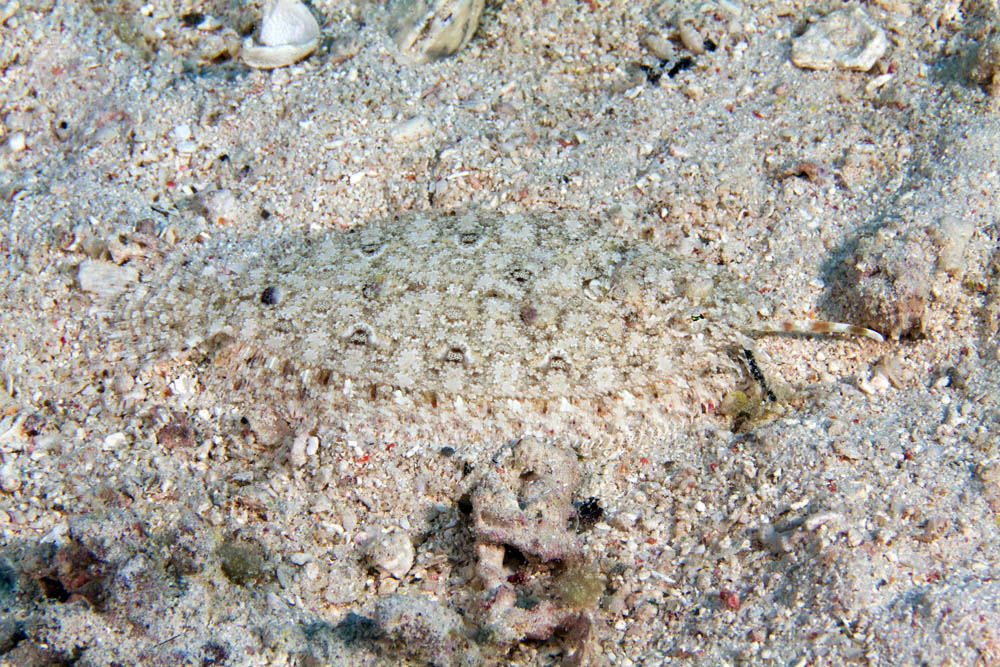Longlure Flounder, Asterorhombus filifer Hensley & Randall 2003
Other Names: Longfin Flounder

Longfin Flounder, Asterorhombus filifer, in Fiji. Source: Paddy Ryan / http://www.ryanphotographic.com/. License: All rights reserved
Summary:
This pale brown flounder is covered in a finely mottled pattern of pale and dark spots and larger dark-edged brown blotches, and with dark blotches or short bars separated by white spots on the bases of dorsal and anal fins.
The first dorsal-fin ray is elongate and separated from the rest of the dorsal fin. It comprises a central stalk and a narrow-smooth-edged membrane., and is used as a lure to attract prey of small fishes and crustaceans.
The first dorsal-fin ray is elongate and separated from the rest of the dorsal fin. It comprises a central stalk and a narrow-smooth-edged membrane., and is used as a lure to attract prey of small fishes and crustaceans.
Cite this page as:
Dianne J. Bray, Asterorhombus filifer in Fishes of Australia, accessed 27 Jun 2025, https://fishesofaustralia.net.au/Home/species/947
Longlure Flounder, Asterorhombus filifer Hensley & Randall 2003
More Info
|
Distribution |
Escape Reef, Great Barrier Reef, Queensland. Elsewhere the species occurs in the Indo-Pacific, from South Africa to the Hawaiian Islands. Inhabits sandy and rubble bottoms near reefs, in gullies, and cave entrances. |
|
Features |
Dorsal fin 81-88; Anal fin 63-69; Pectoral fin 11-12 (eyed side), 9-11 (blind side); Pelvic fin 5-6; Gill rakers 0-2 + 6-10; Lateral line scales 56-67. Body depth 2.0-2.5 in SL (40.4-50.1 SL); sexual dimorphism in interorbital width in specimens larger than ca. 60 mm SL, 8.9-18 in HL (1.6-3.1 % SL) in males, 15-21.2 (0.9-2.3 % SL) in females; gill-rakers short, flattened, with strong spinules on margin; uniserial dentition in both jaws. First dorsal-fin ray separated from remainder of fin, elongate, 0.8-1.7 in head length (HL), posterior membrane on ray broad, with a smooth margin, and running nearly entire length of ray; eyes usually with a single tentacle, frequently branched. Scales on eyed side ctenoid; cycloid scales on blind side |
|
Feeding |
Feeds on small fishes and crustaceans attracted to the elongated first dorsal-fin ray. |
|
Similar Species |
Asterorhombus filifer differs from the Angler Flatfish, A. cocosensis in having a more slender body, usually a longer first dorsal-fin ray with a simpler membrane, a narrower interorbital space, and usually a single tentacle on both eyes (vs. 1-9 tentacles on the upper eye only in A cocosensis). Males of both A. cocosensis and A. filifer have a wider interorbital space than females. The Longlure Fllounder differs from the Blotched Flounder, Asterorhombus intermedius, in having a longer first dorsal-fin ray with a smooth edge on the membrane, usually more lateral-line scales, and males with a wider interorbital space than females. |
|
Etymology |
The specific name filifer is from the Latin filum, meaning filament, and fero, meaning carry, in reference to the long first dorsal-fin ray, especially as it appears in small specimens and when the membrane is folded around the ray. |
|
Species Citation |
Asterorhombus filifer Hensley & Randall 2003, Smithiana. Special Publications 2: 2, figs 1, 2, 3A. Type locality: wreckage at shore between cargo pier and launching ramp, Midway Atoll, Hawaiian Islands, 3-5 m. |
|
Author |
Dianne J. Bray |
|
Resources |
Longlure Flounder, Asterorhombus filifer Hensley & Randall 2003
References
Allen, G.R. & Erdmann, M.V. 2012. Reef fishes of the East Indies. Perth : Tropical Reef Research 3 vols, 1260 pp.
Hensley, D.A. 2005. Revision of the genus Asterorhombus (Pleuronectiformes: Bothidae. Copeia 2005(3): 445-460.
Hensley, D.A. & Randall, J.E. 2003. A new flatfish of the Indo-Pacific genus Asterorhombus (Pleuronectiformes: Bothidae). Smithiana Special Publications 2: 1-9 PDF
Munroe, T.A. 2015. Family Bothidae, pp 1673-1681. In Roberts, C.D., Stewart, A.L. & Struthers, C.D. (eds) The Fishes of New Zealand 4: 1153-1748.
Munroe, T. 2016. Asterorhombus filifer. The IUCN Red List of Threatened Species 2016: e.T69741907A69742789. http://dx.doi.org/10.2305/IUCN.UK.2016-3.RLTS.T69741907A69742789.en. Downloaded on 10 February 2018.
Randall, J.E. 2005. Reef and shore fishes of the South Pacific. New Caledonia to Tahiti and the Pitcairn Islands. Honolulu : University of Hawaii Press 707 pp.



